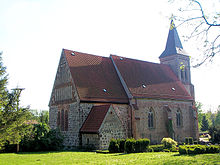Kessin (Dummerstorf)
|
Kessin
Dummerstorf municipality
Coordinates: 54 ° 3 ′ 46 ″ N , 12 ° 10 ′ 40 ″ E
|
|
|---|---|
| Height : | 6 m |
| Area : | 10.97 km² |
| Residents : | 1478 (Dec. 31, 2007) |
| Population density : | 135 inhabitants / km² |
| Incorporation : | June 7, 2009 |
| Postal code : | 18196 |
| Primaries : | 0381, 038208 |
Since June 7, 2009, Kessin has been part of the municipality of Dummerstorf in the Rostock district in Mecklenburg-Western Pomerania (Germany).
geography
Kessin is located on the lower Warnow , two kilometers southeast of Rostock .
The districts Beselin and Hohen Schwarfs belonged to the former municipality of Kessin.
history
In documents from the 12th century, the place Goderac is mentioned, named after the local Slavic deity of the same name. The place name was changed to Godehardsdorf by the Schwerin bishop Berno . This designation was confirmed in Schwerin on September 9, 1171 by Duke Heinrich the Lion in a document. Later the place got its current name after the princely castle Kessin , which was in the immediate vicinity. The name of the Kizun Castle was mentioned as early as 1121. It was said that she was "more famous and richer in treasures than anyone else". Up to 1211, the Bishop Brunward in Schwerin was granted partly the castle district of Kessin, partly only the village of Goderac and a neighboring village. In 1219 Prince Heinrich Borwin I placed the Kessin church with the village of Roggentin under the patronage of the Sonnenkamp monastery ( Neukloster ). Prince Nikolaus I , the then lord of Rostock, had elevations from the village of Goderac in favor of the Doberan monastery . In 1269 the choir of today's church was completed and presumably because of the similarity of the name to Goderac it was consecrated to Saint Godehard of Hildesheim.
From 1305 to 1350, the Rostock family Quast owned Kessin and various neighboring villages. The latter then sold their property to the Kröpelin family, who soon acquired Roggentin as well. When the last family member died in 1496, part of Kessin came to the Kerkhof family in Rostock . Soon afterwards, Kessin belonged to the civil estates that were confiscated by the dukes Magnus and Balthasar as a result of their feud with the city of Rostock and only returned by duke Heinrich V in 1528 for a payment of 1,600 guilders. In the course of the following century, in addition to the Kerkhofs, other Rostock families also appeared as owners of farms in Kessin. In 1601 the Rostock mayor Friedrich Hein bought the Kerkhofschen estates Bartelsdorf, Kessin, Harmstorf and Bentwisch . These had been pledged to him since 1598. Since then, Kessin has belonged to Bartelstorf.
The city of Rostock owned these goods from 1620 to 1684. From 1684 the Ribnitz monastery owned Bartelstorf and thus also Kessin. After a lengthy process, Kessin was bought back by the city of Rostock on December 18, 1781. Since then, Kessin has again belonged to the estates of the city of Rostock. Protocols from the end of the 18th century show that many people in Kessin at that time were still living as serfs.
Incorporation
On June 7, 2009, Kessin became a district of the non-governmental municipality of Dummerstorf. This was formed from the six previously independent municipalities of the Warnow-Ost office, which was dissolved at the same time .
Transport links

By the place leading national road 103 , the highway access Kessin to the motorway 19 is located near the junction Rostock (motorways 19/ 20 ). The Rostock – Tribsees / Ticino railway runs near Kessin , but Kessin has no stopping point . Trains of the RB 11 run Wismar – Rostock – Tessin.
Sports
The place is known for its activities through the Olympic Rowing Club Rostock (ORC), which has its training ground in Kessin, and the ball sports club (BSV Kessin).
Sons and daughters
- Wilhelm Krüger (* 1775 in Hohen Schwarfs; † September 7, 1850 in Penzlin ), German history painter
Individual evidence
- ↑ Dendrochronological report from 2008
- ↑ StBA: Area changes from January 2nd to December 31st, 2009

